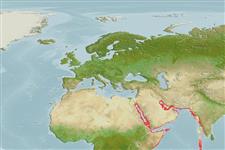Teleostei (teleosts) >
Ovalentaria/misc (Various families in series Ovalentaria) >
Pomacentridae (Damselfishes) > Chrominae
Etymology: Chromis: Greek, chromis = a fish, perhaps a perch (Ref. 45335).
More on author: Randall.
Environment: milieu / climate zone / depth range / distribution range
Ecology
Marine; reef-associated; depth range 0 - 18 m (Ref. 11441). Tropical
Western Indian Ocean: Arabian Peninsula from the northern Red Sea to the Persian Gulf.
Size / Weight / Age
Maturity: Lm ? range ? - ? cm
Max length : 7.2 cm TL male/unsexed; (Ref. 11441)
Dorsal spines (total): 12; Dorsal soft rays (total): 10 - 12; Anal spines: 2; Anal soft rays: 11. Body olive brown, the scale edges darker, shading to gray ventrally. Margin of spinous portion of dorsal and anal fins and lateral edge of pelvic fins blue. The axil of the pectoral fins bright orange-yellow. Caudal fin light greenish gray with a broad black band in each lobe and a narrow blue upper and lower margin.
Adults form aggregations on reefs to feed on zooplankton. Take shelter in branching corals (Ref. 11411). Oviparous, distinct pairing during breeding (Ref. 205). Eggs are demersal and adhere to the substrate (Ref. 205). Males guard and aerate the eggs (Ref. 205)..
Life cycle and mating behavior
Maturity | Reproduction | Spawning | Eggs | Fecundity | Larvae
Oviparous, distinct pairing during breeding (Ref. 205). Eggs are demersal and adhere to the substrate (Ref. 205). Males guard and aerate the eggs (Ref. 205).
Randall, J.E., 1995. Coastal fishes of Oman. University of Hawaii Press, Honolulu, Hawaii. 439 p. (Ref. 11441)
IUCN Red List Status (Ref. 130435: Version 2024-1)
Threat to humans
Harmless
Human uses
Tools
Special reports
Download XML
Internet sources
Estimates based on models
Preferred temperature (Ref.
123201): 26.1 - 29.2, mean 27.8 °C (based on 315 cells).
Phylogenetic diversity index (Ref.
82804): PD
50 = 0.5000 [Uniqueness, from 0.5 = low to 2.0 = high].
Bayesian length-weight: a=0.01820 (0.00804 - 0.04119), b=2.99 (2.81 - 3.17), in cm total length, based on LWR estimates for this Genus-body shape (Ref.
93245).
Trophic level (Ref.
69278): 3.4 ±0.45 se; based on food items.
Resilience (Ref.
120179): High, minimum population doubling time less than 15 months (Preliminary K or Fecundity.).
Fishing Vulnerability (Ref.
59153): Low vulnerability (10 of 100).
Nutrients (Ref.
124155): Calcium = 153 [75, 261] mg/100g; Iron = 0.981 [0.549, 1.699] mg/100g; Protein = 18.2 [17.0, 19.4] %; Omega3 = 0.124 [0.067, 0.220] g/100g; Selenium = 20.2 [9.8, 42.5] μg/100g; VitaminA = 166 [48, 562] μg/100g; Zinc = 1.71 [1.09, 2.56] mg/100g (wet weight);
